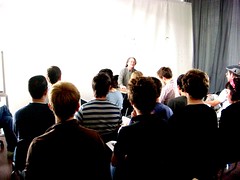New exhibition and conference starting the FACT programme. Looks good!
"Designer hymens, a composite coat made of blended skin cultures by legendary French artist ORLAN, a brain infused with glowing moss and non-animal ‘leather’ growing in the galleries, FACT (Foundation for Art and Creative Technology) presents a ground-breaking UK exhibition exploring the idea of skin as a place where art, science, philosophy and social culture meet.sk-interfaces opens 01 February until 31 March 2008.
Curated by Jens Hauser, sk-interfaces launches FACT’s Human Futures programme in Liverpool’s year as European Capital of Culture and as an interdisciplinary exhibition will feature works from 15 international artists, including 2007’s Golden Nica winners at Ars Electronica.
“What used to be understood as a surface that represents the limit of the self and between the inside and the outside can today be seen as an unstable border. sk-interfaces is ideally placed within the cultural programme of Liverpool 08: Artists are exploring trans-species relationships, xenotransplantation, satellite bodies, endogene design, telepresence, permeable architecture and the ever pushed limits of art itself,” says curator Jens Hauser.
Formerly known for her surgery-performances in which she refigured her face and created new images referring to non-Western cultures, ORLAN presents her new work Harlequin Coat, a patchwork life-size mantle, which contains fusing in vitro skin cells from various cultures and species. This prototype of a biotechnological coat is made to symbolise cultural cross breeding.
The Tissue Culture and Art Project’s Victimless Leather investigates the possibility of producing ‘leather’ without killing an animal. Three miniature stitch-less garments are tissue-cultured live in the gallery. Artists Oron Catts and Ionat Zurr are behind the award-winning lab project SymbioticA (Golden Nica in Hybrid Art 2007 Prix Ars Electronica), the Australian–based research facility dedicated to artistic enquiry.
French duo Art Orienté objet has created biopsied, cultured, hybridized and tattooed skin made from their own epidermis and pig derma to create living biotechnological self-portraits. Marion Laval-Jeantet and Benoît Mangin’s work is intended to be grafted onto collectors themselves so they can physically wear and absorb an artists’ piece.
American artist Julia Reodica’s hymNext Designer Hymen Series confronts the values of purity and gender roles using the artist’s own vaginal tissue and animal muscle cells to create designer hymens. The sculptures pose as products to be marketed and are intended as objects of novelty for ‘re-virginisation’ thus addressing the issue of how different cultures value female virginity and the associated pressures.
Zbigniew Oksiuta from Poland will come to Liverpool to create a new version of his project Breeding Spaces in which a large 3D sphere of gelatin is grown in situ. The artist proposes the possibilities of designing biological spatial structures that can serve as a new kind of habitat and presents a new form of spatial coexistence between man and nature.
sk-interfaces will also feature further commissioned and existing projects from international artists such as Eduardo Kac, Jun Takita, Wim Delvoye, Olivier Goulet, Zane Berzina and Neal White among others.
Mike Stubbs, Director and CEO of FACT says, “FACT opens its 08 programme committed to pushing at the boundaries of how and what creative technologies and art can be. Touching on some of the biggest issues of our day FACT invites debate and conversation around life sciences and our changing relationships with our bodies and technology"."


